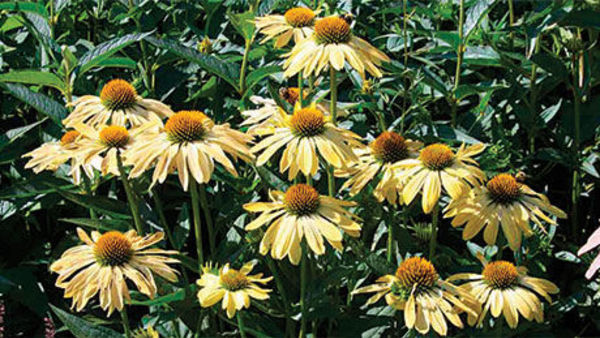|
|

Overused: Japanese spirea (Spiraea japonica* cvs.) |
1. New Jersey Tea
Name: Ceanothus americanus
USDA Hardiness Zones: 4 to 8
Size: 3 to 4 feet tall and wide
Conditions: Full sun; well-drained soil
New Jersey tea is a small, attractive, deer-resistant summer-flowering shrub that won’t reseed itself like the popular—but invasive—Japanese spirea. In midsummer, large white puffs of honey-scented blooms cover this Northeast native, attracting butterflies and pest-eating predatory insects. Drought tolerant, it grows in poor, rocky soils without any fuss or fertilizer. Use it in foundation plantings or perennial beds where you don’t want too much height. A hard winter pruning every few years keeps it neat and tidy but is not necessary.
|
|

Overused: Periwinkle (Vinca minor* and cvs.) Photo: Steve Aitken |
2. Wintergreen
Name: Gaultheria procumbens
Zones: 3 to 8
Size: 3 to 6 inches tall and up to 3 feet wide
Conditions: Partial shade; moist, well-drained, acidic soil
Wintergreen is one of those rare plants: a shade-loving evergreen ground cover that won’t take over and disrupt local ecosystems. It thrives in dry shade but will grow in any well-drained, acidic soil. Tiny pink-tinged white flowers appear in spring, feeding native bumblebees with their nectar. Its edible, bright red fruit have the familiar cool tang of wintergreen, and the leaves have been used medicinally for centuries. The fruit persist through winter, contrasting beautifully with snow on the forest floor or in your garden.
|
|

Overused: Miscanthus (Miscanthus sinensis* cvs.) |
3. Pink Muhly Grass
Name: Muhlenbergia capillaris
Zones: 5 to 9
Size: 2 to 3 feet tall and wide
Conditions: Full sun; well-drained soil
Miscanthus is popular for fall interest, but its overwhelming mass makes it gawky. The beautiful native pink muhly grass remains a few feet in height and width, making it perfect in small gardens or meadow drifts. Green clumps form through summer, but its real value is in fall, when seeds have ripened to a stunning rose-red. Plant where you can view the tassels backlit by the sun. A cloud of pink muhly grass turns a late-summer/fall bed into a work of impressionist art. Plant with New England aster (Symphyotrichum novae-angliae, Zones 4–9) for a spectacular autumn display.
Ellen Walther Sousa, of Spencer, Massachusetts, is author of The Green Garden: A New England Guide to Planning, Planting, and Maintaining the Eco-Friendly Habitat Garden.
Photos, except where noted: Michelle Gervais




















Comments
Log in or create an account to post a comment.
Sign up Log in